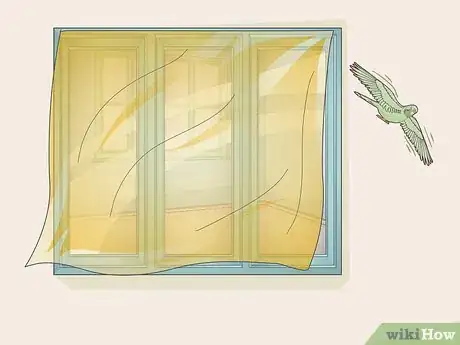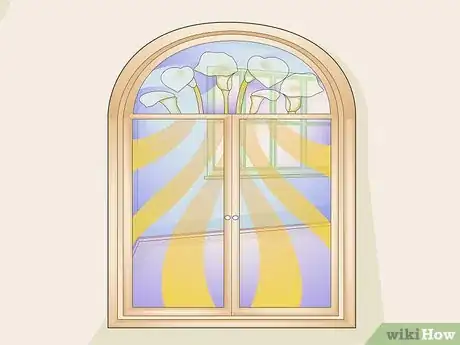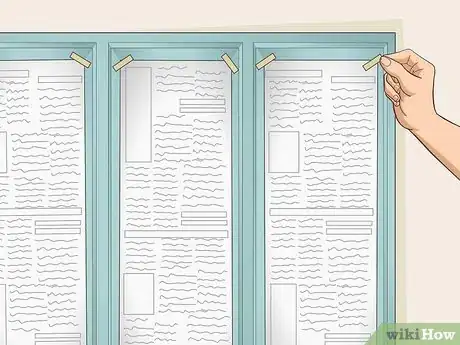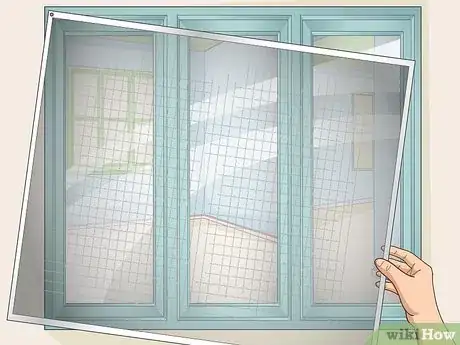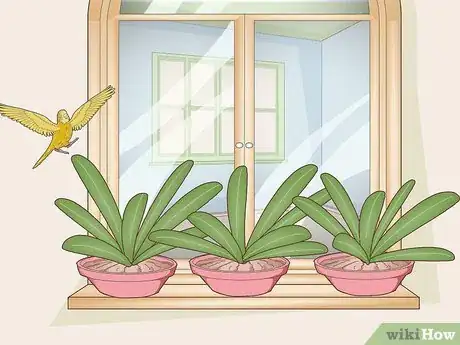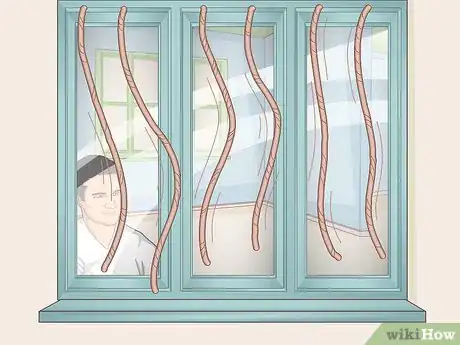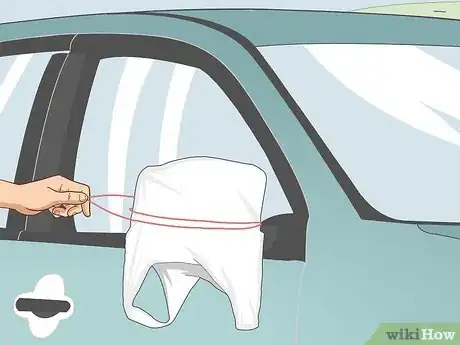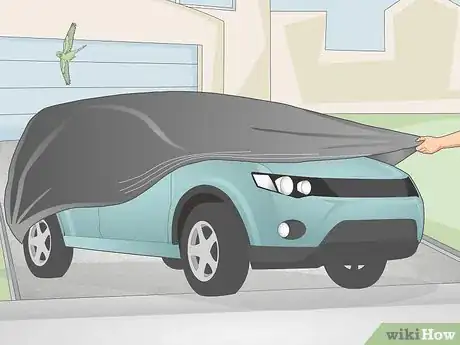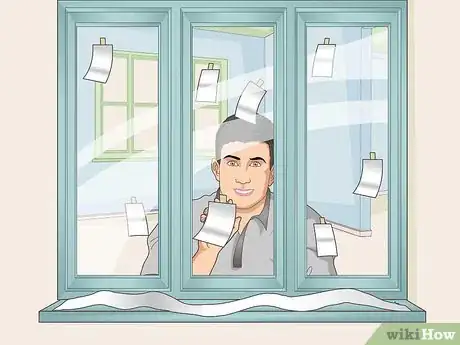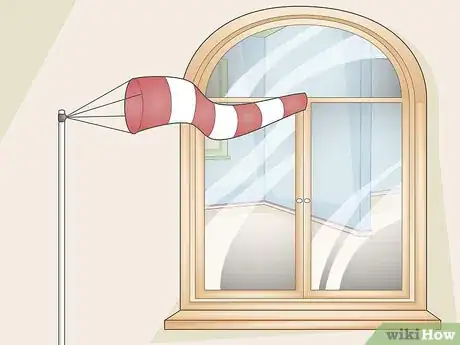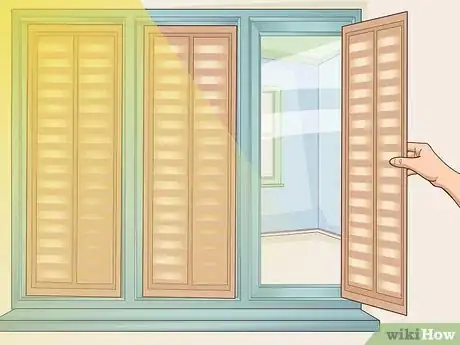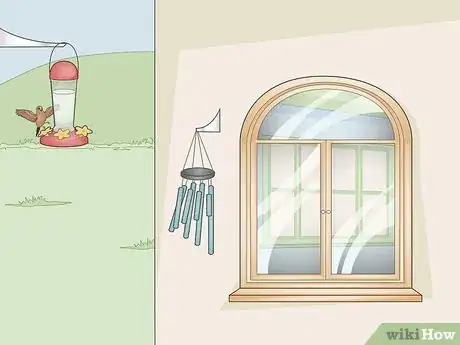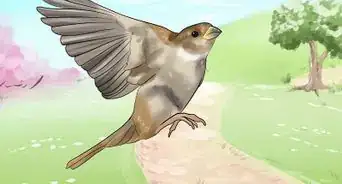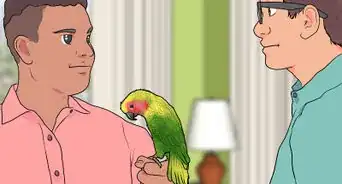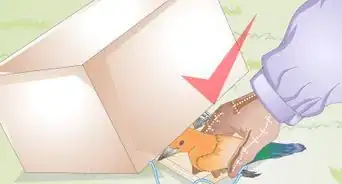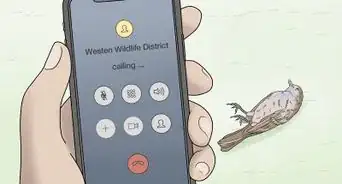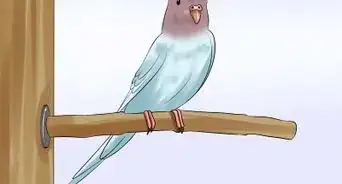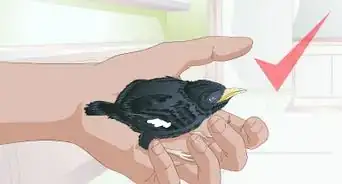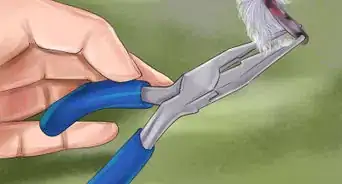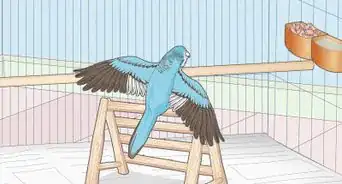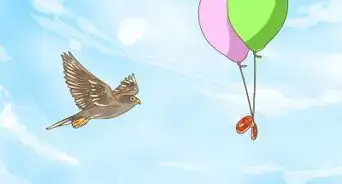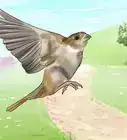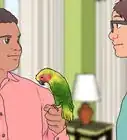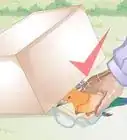This article was co-authored by wikiHow staff writer, Eric McClure. Eric McClure is an editing fellow at wikiHow where he has been editing, researching, and creating content since 2019. A former educator and poet, his work has appeared in Carcinogenic Poetry, Shot Glass Journal, Prairie Margins, and The Rusty Nail. His digital chapbook, The Internet, was also published in TL;DR Magazine. He was the winner of the Paul Carroll award for outstanding achievement in creative writing in 2014, and he was a featured reader at the Poetry Foundation’s Open Door Reading Series in 2015. Eric holds a BA in English from the University of Illinois at Chicago, and an MEd in secondary education from DePaul University.
There are 8 references cited in this article, which can be found at the bottom of the page.
This article has been viewed 46,966 times.
Learn more...
Some territorial birds will attack windows during their breeding season. When they see their reflection, they think another bird has entered their breeding ground and will aggressively peck or fly at the window. To prevent or stop birds from attacking your windows, you can reduce the reflection in your window pane, set up precautionary measures to scare birds away, or simply block the landing platform on the window. Keep in mind that you likely need a temporary solution, since most birds will give up after a few weeks once their breeding season is over.
Steps
Hiding Windows
-
1Hang a plastic drop cloth over your window to efficiently deter birds. Hanging a medium-weight plastic drop cloth or sheet will remove the reflection from the exterior side of your window will remove the window’s reflection without keeping light out. Purchase a plastic drop cloth and either nail it into the top of your window frame with small nails and a hammer, or use double-sided tape to stick it in place.[1]
- You can use a plastic shower curtain instead of a drop cloth, but these tend to be a little lighter. If you live in a windier area, it may blow off.
- This is the most efficient option if you value the natural light coming in through your window.
Tip: The wavy motion of the drop cloth in the wind will also deter birds from inspecting your window in the event that they catch a glimpse of themselves. Birds tend to distrust unpredictable or abrupt movement.
-
2Cover windows with film to reduce reflections. Stained glass, mosaic, or pattered window film is a great way to reduce reflections while adding a little artistic flourish to a room. Pick up some adhesive window film online or from a craft store. Peel the back off and attach it to the interior side of your window. Smooth the film out with a credit card and cut the excess film off with a razor blade.[2]
- Clean your window thoroughly with a cleaning solution and let it air dry before installing window film.
- If you choose a white or translucent window film, birds may still be able to see their reflections.
Advertisement -
3Tape bright paper or newspaper to your window to remove reflections. To completely remove the possibility that the bird will see their reflection, tape sheets of bright paper or newspaper to the inside of your window. This will distract and obscure the bird’s vision when they look at the window and they’ll be unlikely to catch their reflection. However, it will greatly reduce the amount of light that comes into your room.[3]
- This is a great option if you live in an area near a lot of other homes. Once the bird stops attacking, it’s a sign that they’ve found somewhere else to go and you can probably take the paper off.
- This is the best way to deal with attacking birds if you really don’t care about the light coming in through your window.
-
4Install window screens on the exterior of your windows. Window screens are the mesh frames that keep bugs and leaves out of your home when you open the window. They will also keep birds from seeing themselves in the mirror and block them from pecking at it. If you have slots for the screens, purchase screens based on the width of your window and slide them into place. If you don’t have slots, get pre-framed screens that expand and stick inside the bottom of your window frame.[4]
- If you don’t have slots for window screens on your windows but want them to look good, you’ll need to hire a contractor to install them for you.
- The pre-framed screens slide out and use tension to keep them in place.
- In rare cases, birds will look like they’re attacking the mesh. This is usually just a bird trying to collect small items for a nest, though. To stop birds from pecking at window screens, get wire mesh screens that can’t be clipped by a bird’s beak and they’ll simply give up after a few failed attempts.
-
5Put plants on your window sill to remove the landing platform. If you don’t live in a windy area and have a large window sill on the exterior side of your windows, put flowers or plants on the sill. This will block birds from landing on your screen and give them something else to look at when they fly past, which will reduce the odds that they see their reflection in the first place.[5]
- Some birds will attempt to land on top of the flowers or plants once they see their reflection, but you can simply remove the plants if this happens and use another option.
-
6Hang rope or string from the top of the window to dissuade landings. Get some rope, twine, or string at least 0.5 inches (1.3 cm) in width. Open the top of your window and stick the twine or string in between the frame and the window before closing it to hang it over the exterior side of the glass. Alternatively, you can tape the rope or twine to the sill using heavy-duty tape. This will deter birds from landing on the sill since it will look like they’re moving in the wind and blocking the window.[6]
- How many lengths of string or twine you use depends on the size of the bird that is attacking your window. For smaller birds, place a length of string once every 1–2 inches (2.5–5.1 cm); for larger birds, put a string once every 4–5 inches (10–13 cm).
Tip: If you use this option and birds continue to attack your window, inflate some balloons with air. Tie the balloons to the end of the string and let them hang from your window sill.
-
7Hang grocery bags over your side mirrors to keep birds off of them. If birds are attacking your vehicle’s side mirrors, slide a plastic grocery bag over each mirror whenever you park. Wrap a rubber band around each mirror to keep the bag from blowing off into the wind. This will block the mirror from bird attacks and keep them from seeing their reflection.[7]
- If you have adjustable windows that pivot towards your vehicle to protect them from sideswipes, turning the mirrors inside whenever you park the vehicle can prevent birds from jumping on them.
-
8Protect your vehicle with a car cover to keep birds off of it. A car cover is a tarp designed to protect vehicles from weather and dust. Buy a vehicle cover that fits your make and model online or from an auto supply store. Whenever you park your vehicle, slide the cover over your car and pull it down. This will block birds from your vehicle and keep them from landing on it and seeing their reflection.[8]
- This is basically the only option if birds are seeing their reflection in your vehicle’s paint.
Scaring Birds Away
-
1Place a decoy owl on the window sill to scare birds away. Purchase a decoy owl from a home supply store or online. Put the decoy owl on the exterior side of your window sill to scare birds away. Every 2-3 days, move the position of the owl to keep birds from getting comfortable with the statue.[9]
- This is a pretty simple solution, but it won’t work for some birds that have seen decoy owls before.
-
2Layer aluminum foil around the window to confuse birds. Tape some sheets of aluminum foil to the inside of your window. Lay another strip of aluminum foil on your window sill and secure it place by sticking the edge in between your window and the frame at the bottom. The aluminum foil will reflect light back on any birds that come by and scare them from approaching the window.[10]
Tip: If a bird does happen to land on the window sill, the noise and texture of the aluminum foil will freak the bird out and they’ll fly away.
-
3Hang a windsock or flag near your window to deter landings. A flag or windsock will blow and move with the wind. This erratic motion will make birds weary and keep them from approaching your window. Purchase a flag or windsock online or from a flag store. Drill the corresponding bracket for a flag or windsock into the exterior frame of your window and insert the windsock.[11]
- A windsock is a conical sheet of fabric that catches the wind and lets you know which direction it is blowing.
- The brackets for windsocks and flags typically come with the item you purchase.
- This is not a particularly good option if you don’t live in particularly windy area. It’s a great option if you consistently have problems with birds attacking a single window, though.
-
4Install shutters on your windows to close them during the day. You can install the shutters yourself or hire a contractor to do it for you. To install them on your own, measure your window and purchase shutters that fit the frame. Install brackets on the inside of your frame and attach the individual shutters with the screws that came with them. During the day, when bird attacks are most likely, shutter you windows to keep birds out.[12]
- It will cost $300-700 per window if you install the shutters yourself. If you hire a contractor, it will cost $400-1,000 a window. The cost fluctuates based on the type of shutter you choose and how big your window is.
- Shutters are nice to have if you live in a hot area. They do quite a good job at keeping heat out when they’re closed.
- If the shutters flap in the wind when they’re open, they will also scare birds away.
-
5Hang bird feeders and wind chimes strategically to keep birds away. Bird feeders attract birds, so hang them away from your windows with plenty of obstructions between the feeder and your home. The movement and sound of wind chimes will deter birds and scare them away, so hang them close to your home. This is a particularly good option if the birds are attacking windows on a porch where there is plenty of room for a wind chime.[13]
- If the wind chime is really quiet, it may actually attract birds.
Warnings
- Decals and stickers will not work unless you cover the majority of the window.⧼thumbs_response⧽
- Depending on where you live, birds are likely legally protected. Do not attack, harm, or injure a bird that is attacking your window.⧼thumbs_response⧽
References
- ↑ https://www.massaudubon.org/learn/nature-wildlife/birds/birds-attacking-windows
- ↑ https://www.backyardbuddies.org.au/buddies-in-trouble/stop-birds-attacking-windows
- ↑ https://www.backyardbuddies.org.au/buddies-in-trouble/stop-birds-attacking-windows
- ↑ https://www.allaboutbirds.org/news/why-birds-hit-windows-and-how-you-can-help-prevent-it/
- ↑ https://www.backyardbuddies.org.au/buddies-in-trouble/stop-birds-attacking-windows
- ↑ https://www.backyardbuddies.org.au/buddies-in-trouble/stop-birds-attacking-windows
- ↑ https://www.massaudubon.org/learn/nature-wildlife/birds/birds-attacking-windows
- ↑ https://www.massaudubon.org/learn/nature-wildlife/birds/birds-attacking-windows
- ↑ https://sciencing.com/owl-work-scare-birds-away-4913851.html
